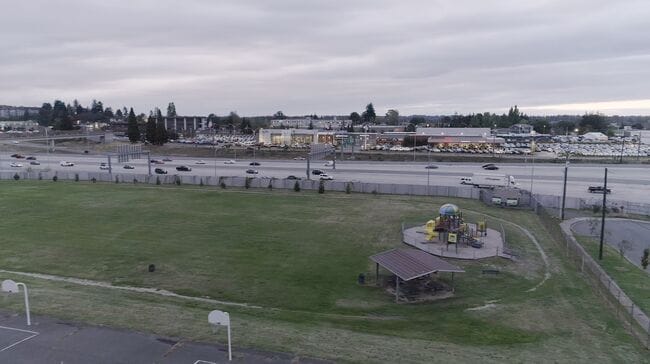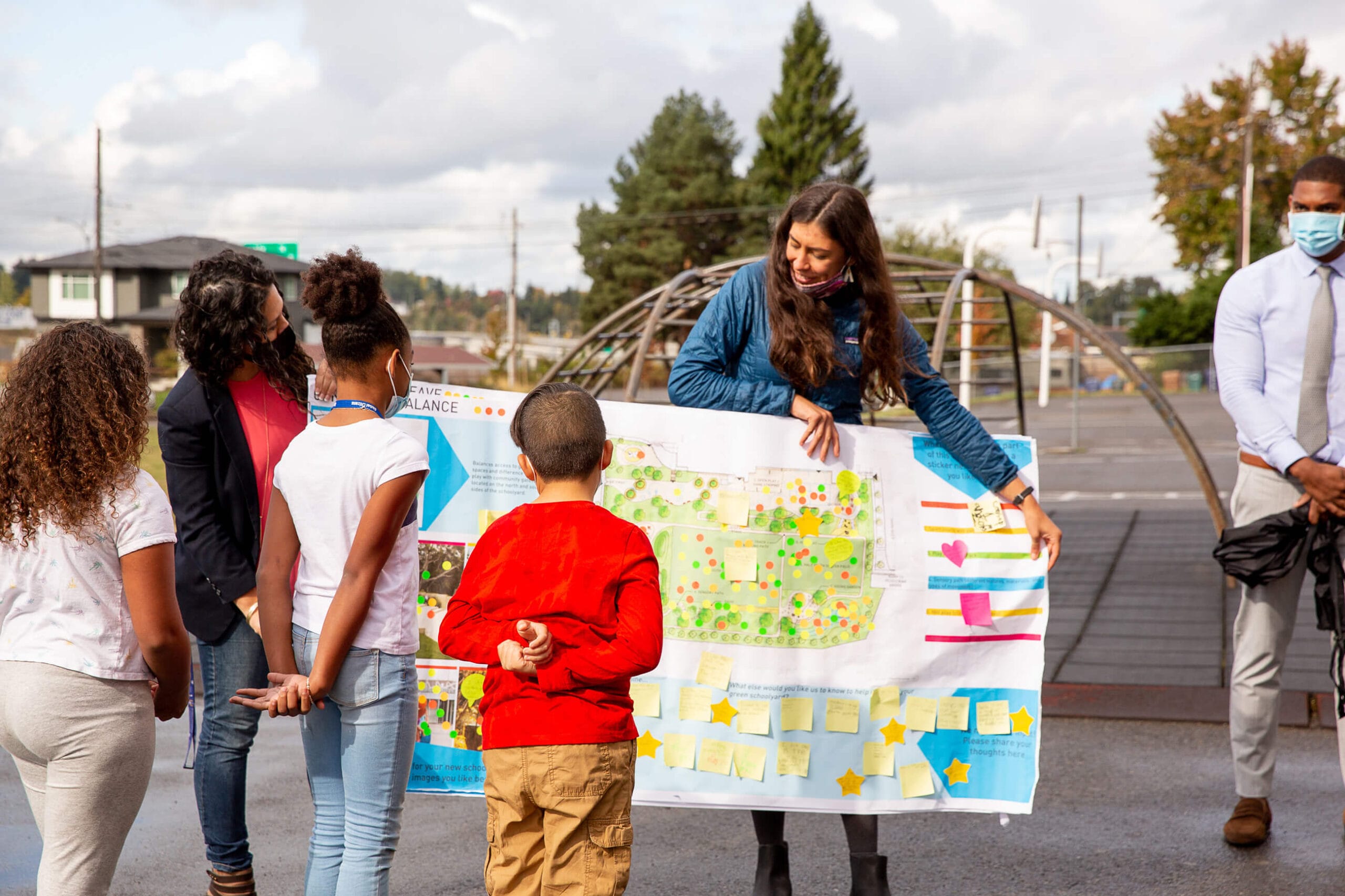When Abby Sloan, principal of Jennie Reed Elementary School in Tacoma, Washington, talks about the problems with the existing schoolyard, she almost doesn’t know where to begin.
First, there is the noise that emanates from the eight-line interstate that runs right past the school property. “We can hardly hear ourselves speak,” Sloan said. “I’m a 40-year-old woman who is supposed to have her stuff together, and I get triggered by the noise.”
Then there is the flooding, which renders the grassy field useless for much of the school year. “We call it Lake Reed,” she quipped. “One-third of the field is underwater from November to April. The rest of the field is muddy.”
And finally, you have the dated—some might say antiquated—play structures. “We are talking about 1950s equipment,” Sloan said. “Forget about the noise. There’s the injustice that comes from having play equipment from 70 years ago.”
 Traffic on Interstate 5 whizzes by the playing field at Jennie Reed Elementary School in Tacoma, Washington. Photo: Christopher Harrell
Traffic on Interstate 5 whizzes by the playing field at Jennie Reed Elementary School in Tacoma, Washington. Photo: Christopher Harrell
For those reasons (and others), Jennie Reed is one of six Community Schoolyards™ projects we’re now pursuing in Tacoma. The city of 213,000, notably lacking in parkland, is often overshadowed by Seattle, its bigger, wealthier, greener neighbor to the north. Despite having some of the best public parks in Washington, Tacoma also has one of the lowest 10-minute walk access scores of any city in the state. That means fewer residents can reach a park within a ten-minute walk of their homes.
Tacoma is a recent addition to the organization’s schoolyards program, which began 25 years ago in New York City and has since spread to other cities in the East, including Philadelphia and Atlanta, as well as the West, including Dallas, Los Angeles, and Oakland, California. Nationwide, we have so far renovated nearly 300 public schoolyards, transforming barren asphalt spaces into colorful green oases that are open to the public after school and on weekends. Designed by students with help from professional landscape architects, the new and improved schoolyards become a community asset; they have given more than four million residents across the country a new park within a 10-minute walk of home. In fact, one of the biggest benefits of Community Schoolyards is that it improves park access for entire communities.
On October 7, Brenda Mallory, chair of the White House Council on Environmental Quality, and Congresswoman Marilyn Strickland, whose district includes Tacoma, toured the Jennie Reed Elementary schoolyard. The visit highlighted the Biden-Harris administration’s efforts to improve equitable access to green spaces as a part of the “America the Beautiful” Initiative. That initiative aims to conserve 30 percent of the nation’s lands and waters by 2030.
 Brenda Mallory, chairwoman of the White House’s Council on Environmental Quality, visits Jennie Reed Elementary School in Tacoma, Washington, in October 2021. Photo: Adair Freeman Rutledge
Brenda Mallory, chairwoman of the White House’s Council on Environmental Quality, visits Jennie Reed Elementary School in Tacoma, Washington, in October 2021. Photo: Adair Freeman Rutledge
During the visit, our work at Jennie Reed was held up as a model for closing the park-equity gap.
“We know that the impacts of the climate crisis are felt more acutely by low-income communities and communities of color,” Mallory said. “As part of our efforts to reduce these impacts, we must take steps to create safe outdoor opportunities in nature-deprived communities, while increasing outdoor recreation access. Projects like those happening here at the Reed Elementary Green Schoolyard embody the principles of the America the Beautiful Initiative and are examples of the types of partnerships we need to increase green spaces in a just and equitable way for all.”
Community Schoolyards spaces are packed with environmental and climate benefits, too. New trees provide cooling shade. Rain gardens and engineered soils beneath turf fields capture and hold stormwater. And pavement is painted in colors that deflect heat. The result is a space that not only helps cities address flooding and other issues, but that gives students a healthy environment in which to play and learn.
We don’t randomly select schoolyards for renovation, however. The organization’s program experts work with in-house data scientists to determine where the greatest need exists, based on a broad range of factors. Among other things, those factors include health metrics like the prevalence of obesity, diabetes, asthma, and depression; heat, flooding and climate data; park availability and need, and equity indicators relating to income, race, ethnicity, and educational attainment.
 Designed by students with help from professional landscape architects, the new and improved schoolyards become a community asset. Photo: Adair Freeman Rutledge
Designed by students with help from professional landscape architects, the new and improved schoolyards become a community asset. Photo: Adair Freeman Rutledge
In the case of Jennie Reed Elementary, the student body and surrounding community checked a number of boxes. But Sloan’s passion also propelled the school to be one of the first implemented pilots, along with Helen B. Stafford Elementary.
“Abby Sloan really believes in her students and understands how a new schoolyard stands to benefit everyone,” said Quena Batres, our Northwest community engagement manager.
While there may be no easy fix for the cacophony from the freeway, making the field usable throughout the school year will help shield students from some of the noise the traffic generates. When the field is unusable, students are confined to an elevated strip of blacktop next to the school building. That puts them above the barrier. “The sound goes right in your face,” Sloan points out. “But down on the field, closer to the highway, it’s actually quieter. So, if the students can spend more time there, then the barrier will be more effective.”
Sloan said that including the students in the design process opened their eyes to the environmental injustices in their own backyard. It was also empowering. “Children need to see that they have a voice,” she said.
Rising temperatures, bigger storms, and asphalt schoolyards pose significant risks during recess. Urge Congress to prioritize schoolyards that cool neighborhoods, manage stormwater, and provide opportunities for kids to connect with nature today!

